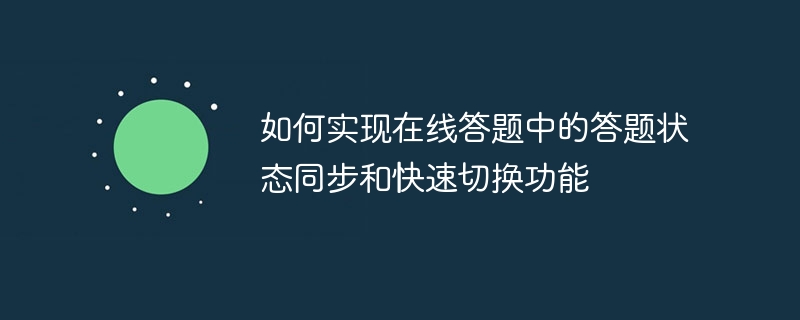

How to implement the answering status synchronization and quick switching functions in online answering requires specific code examples
In modern education and training, online answering systems are widely used. However, traditional online answering systems have some problems in answering status synchronization and quick switching. For example, users may lose answering data when switching questions, or status synchronization cannot be achieved when answering questions on multiple devices at the same time. In order to solve these problems, this article will introduce a method to implement the answering status synchronization and fast switching functions in online answering, and provide specific code examples.
First of all, the answering status synchronization function means that when answering questions on multiple devices, the user's answering status can be synchronized in real time. In order to realize this function, we can use the server-side database to store the user's answering status. When a user submits an answer on a device, the system sends the answer data to the server and updates the corresponding answer status in the database. When the user switches to another device, the system can obtain the user's answering status from the server and restore the user's previous answering progress on the new device.
The following is a simple code example to demonstrate how to implement the answer status synchronization function.
// 客户端代码
function submitAnswer(answer) {
// 提交答案到服务器
// ...
// 更新本地答题状态
updateLocalStatus(answer);
}
function updateLocalStatus(answer) {
// 更新本地答题状态
// ...
// 更新服务器端答题状态
updateServerStatus(answer);
}
function updateServerStatus(answer) {
// 向服务器发送答题状态更新请求
// ...
// 更新服务器端答题状态成功后,获取最新的答题状态
getServerStatus();
}
function getServerStatus() {
// 从服务器端获取最新的答题状态
// ...
// 更新本地答题状态
updateLocalStatus(answer);
}
// 服务器端代码
function handleAnswerSubmission(answer) {
// 处理答案提交请求
// ...
// 更新数据库中的答题状态
updateDatabaseStatus(answer);
}
function updateDatabaseStatus(answer) {
// 更新数据库中的答题状态
// ...
// 返回最新的答题状态给客户端
return getDatabaseStatus();
}
function getDatabaseStatus() {
// 从数据库中返回最新的答题状态
// ...
// 返回最新的答题状态给客户端
return status;
}The client code and server code in the above code example show the basic implementation method of the answer status synchronization function. When the user submits an answer on the client, the client will send an answer status update request to the server and update the local and server-side answer status. When the user answers a question on another device, the client will obtain the latest answering status from the server and update the local answering status.
In addition to the answering status synchronization function, the quick switching function is also a common requirement in online answering systems. Users may switch between different questions and want to switch quickly without reloading the page. In order to realize this function, we can use front-end frameworks, such as React or Vue, to dynamically render the page and manage the switching of different topics through the routing mechanism.
The following is a simple code example to demonstrate how to implement the fast switching function.
import React from "react";
import { BrowserRouter as Router, Switch, Route } from "react-router-dom";
function App() {
return (
<Router>
<Switch>
<Route path="/question/:id" component={Question} />
</Switch>
</Router>
);
}
function Question() {
// 根据题目id获取题目信息,并动态渲染题目页面
// ...
}
export default App;In the above code example, we use React and React Router to implement dynamic rendering and routing management of the page. When the user chooses to switch to another question on the answer page, the system will obtain the corresponding question information based on the question ID and re-render the question page without reloading the entire page.
To sum up, by using the server-side database to realize the answering status synchronization function, and using the front-end framework and routing mechanism to realize the fast switching function, we can achieve the synchronization and rapid answering status in the online answering system. switch. The code example provided above is just an implementation method, and the specific code implementation can be adjusted according to specific needs and technology stack. I hope this article will be helpful to students who develop online question answering systems.
The above is the detailed content of How to implement the answering status synchronization and quick switching functions in online answering. For more information, please follow other related articles on the PHP Chinese website!




